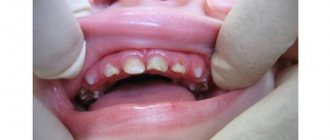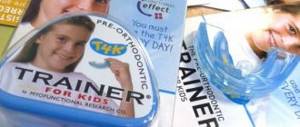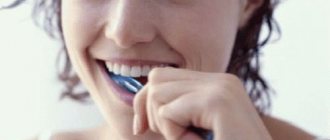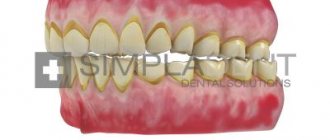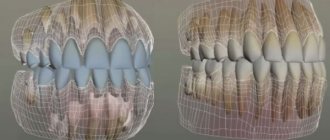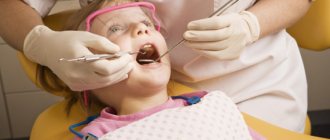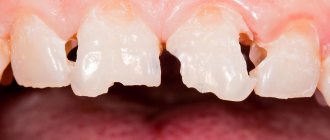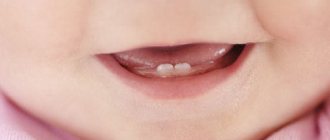“You urgently need to remove the 48th tooth!” - such a statement from the dentist can seriously puzzle the patient, because even from a school biology course everyone knows that there are only thirty-two teeth in the mouth. Where did this mysterious 48th come from, and what is with the strange numbering of teeth among dentists? Cunning doctors have invented a diagram of a person’s teeth with numbers that only they understand, and patients get confused in these numbers, trying to understand what they are talking about and where they suddenly got “extra” dental units from.
In fact, the teeth numbering scheme in dentistry is quite simple, clear and accessible - it was created in order to facilitate the “accounting” of dental units in patients and bring it to some uniform standards. After all, if every dentist starts counting dental units as he pleases, nothing good will definitely come of it. Especially if the patient subsequently gets an appointment with another doctor and he simply does not understand what tooth numbers are indicated in the medical record and what kind of treatment was ultimately carried out earlier.
How dentists count teeth: arrangement and numbering principles
Each dental unit has its own functions, depending on its structure and location on the jaw. Thus, incisors are designed for biting off pieces of food, canines help to hold hard food and “tear off” stubborn pieces, premolars are needed for primary processing, and dense “plump” molars are designed for thoroughly chewing and grinding food. The order of the teeth in the mouth, accordingly, will be as follows: on each jaw there are four incisors, two canines, four premolars (two on each side) and six molars (three on each side).
In dentistry, tooth numbers are assigned according to their location on the jaw and function. Since the incisors and molars are located symmetrically on the right and left, the count starts from the middle of the row, that is, from the central incisors and further to the right and left. If we divide this row into two halves and start counting on one of them, we get: two incisors (teeth numbers 1 and 2), a canine (3rd number), two premolars (4th and 5th), three molar (6th, 7th and 8th, the last one being the wisdom tooth). These are the names and numbers of teeth that are universally accepted in dentistry.
If you have a problem similar to that described in this article, be sure to contact our specialists. Don't diagnose yourself!
Why you should call us now:
- We will answer all your questions in 3 minutes
- Free consultation
- The average work experience of doctors is 12 years
- Convenient location of clinics
Single contact phone number: +7
Make an appointment
But if you simply say “sixth tooth,” then how can you understand whether it is upper or lower, and on which side of the jaw – left or right – it is located? To eliminate confusion in this matter, it is customary to designate a person’s teeth by numbers, indicating the segment of the jaw on which they are located. The segments are considered as follows: the upper right is the first and is indicated by a ten in front of the number of a particular tooth (for example, the 11th is the central right upper incisor, the 16th is the upper right molar, next immediately after the premolars, etc.), the upper left - twenty. Accordingly, the lower left is designated by thirty, and the lower right by the number 40. That is, the segments of the jaws are numbered clockwise, this makes it much easier to remember the order and, if necessary, count.
Thus, the notorious 48th number indicates the location of the wisdom teeth in the lower right segment of the jaw. And insisting on removing the 48th dental unit, the dentist simply indicates what number the wisdom tooth has in the lower right, and does not inform the patient about the supernumerary teeth that came from nowhere in the mouth.
Prevention
In order not to think about how to cure bottle caries in the presence of both severe and mild symptoms, you must follow simple preventive rules:
- regularly visit the dentist (timely detection of the disease in the early stages will allow for high-quality treatment using gentle, painless methods);
- brush your child’s teeth 2 times a day (the procedure is carried out using a silicone tip on a finger, a gauze swab or a regular brush);
- reduce the consumption of confectionery products (cookies, sweets), sweet pastries, store-bought juices and nectars;
- eliminate night feedings, teach the baby to drink from a cup or glass;
- include more fresh vegetables and fruits in your diet (preferably hard ones, so that the enamel is cleaned naturally);
- purchase toothpaste containing fluoride and other minerals;
- try to minimize the use of pacifiers.
From an early age, the child must get used to the need to care for the oral cavity. This will protect him not only from bottle caries, but also from other dental and systemic diseases. Personal and household hygiene is the basis for the education of boys and girls and establishes healthy habits.
What does the diagram of a child’s teeth look like with the numbers of each unit?
The pattern of baby teeth in children differs from the pattern with numbers in adults. Doctors specially designate milk teeth with different numbers so as not to confuse themselves and their patients: after all, a child who was treated for a milk bite in childhood will soon grow up and begin to go to the dentist for treatment of already permanent dental units. And if the same numbering is used in both cases, then there will be incredible confusion in the treatment history - but such a history in the dental record is often extremely important for the further competent and effective elimination of problems of the dental system.
Therefore, the numbering order for baby teeth in children is as follows: the serial number remains the same as in adults (1st, 2nd – incisors, 3rd – canine, etc.), but the segments of the jaws are designated by numbers 50 and 60 for the upper right and left segments and numbers 70 and 80 for the lower left and right, respectively. And when the dentist informs parents that their child has caries on the 82nd tooth, you don’t need to immediately imagine a baby shark with several rows of sharp baby teeth, we are only talking about the second lower right incisor. According to the counting scheme, permanent teeth in children are no different from the scheme of adult molars.
Caries in children: why does it occur?
How to stop caries in a child? This question interests almost all parents, but in order for treatment to be more effective, you need to know the causes of this disease.
- Genetic predisposition.
Genetics is not a direct factor in the development of dental caries, but if parents have a predisposition to dental caries, then their children are likely to have similar dental problems. - Negative effects on the fetus during pregnancy.
Smoking, drinking alcohol and taking certain medications can adversely affect the development of the fetus and cause problems in the formation of tooth enamel (so-called congenital caries in children).
- Poor hygiene.
From the moment the first tooth appears, parents should begin to accustom their children to dental hygiene and help them with this. During the first year, children's teeth are especially sensitive and exposed to the influence of the external environment, so if special hygiene is not carried out, the child's first caries will not be long in coming.
- Wrong diet.
The most common cause of caries at the time of the appearance of a set of baby teeth. Chocolate, sweet drinks and other foods containing carbohydrates and accumulating in the interdental spaces contribute to the development of pathogenic bacteria, leading to the occurrence of disease. Bottle caries, caused by drinking sugary drinks through bottles with special nipples, is especially common.
- Calcium and fluoride deficiency.
Sometimes a child does not receive the required amount of calcium or fluoride, which are the main elements responsible for the integrity of tooth enamel. Diseases of the gastrointestinal tract. Gastritis, ulcers and other stomach diseases change the composition of saliva, as a result of which plaque forms on the teeth much more intensely. Caries in children and adolescents must be prevented, including by visiting a gastroenterologist.
- Infection with bacteria through cutlery and hygiene items.
Harmful microorganisms such as Streptococcus, which are the very “carious monsters,” can enter the child’s oral cavity through a spoon or toothbrush that belonged to a person who already has caries.
International Viola system: a convenient diagram of the arrangement of a person’s teeth by numbers
The described method is very convenient and most common in dentistry. It has received international recognition and has been generally accepted among dentists since 1971, called the two-digit Viola system. The convenience of such a system lies primarily in the fact that there is no need to create a special map of a person’s teeth, the numbering is easily calculated in the mind and information about the condition of certain dental units of the patient can be easily conveyed in an oral conversation, by telephone or by e-mail.
However, many people, having read this far, may say: but our teeth were counted completely differently, and the map contains completely different designations! That’s right, because in addition to the Viola system, there are several other systems that can be used by dentists.
Treatment in dentistry
Treatment in dentistry can occur in several ways. The most popular and effective of them:
- Borovsky-Leus method (a mixture of calcium gluconate is applied to the affected area, and then fluoride gel. The course of treatment lasts an average of three weeks).
- Fluoridation (after professional cleaning, fluoride varnish is applied, as a result of which slow healing occurs).
- Infiltration (a special gel is pumped into the affected area and prevents caries from growing further).
What other options exist for naming a person’s teeth by numbers?
There are three other systems common among dentists that can be used to designate and record dental units:
- A universal alphanumeric system developed by the American Dental Association.
- Zsigmondy-Palmer system. One of the oldest counting systems (it was created back in 1876), it is often used in their practice by maxillofacial surgeons and orthodontists.
- Haderup system.
All of them are convenient and easy to use in their own way, and in all such systems the arrangement of teeth by numbers in adults and children is indicated differently.
Alphanumeric system
It provides an indication of not only the number of the dental unit, but also its functional purpose. Thus, incisors are designated by the letter I, canines by the letter C, premolars by the letter P and molars by the letter M. As for the numbers, they indicate the serial number of a specific functional unit in the segment (whereas in other systems the functions of the dental unit are not taken into account, only its position is taken into account in a row). For example, if according to the Viola system the wisdom tooth is numbered 8, then according to the alphanumeric system it is also designated as M3, that is, the third molar in the segment. Additionally, digital segment designations are also used, which is why the serial number becomes two-digit. The same 48th tooth mentioned more than once with such a scheme will be designated as M43.
For milk teeth, lowercase (small) Latin letters are used in the recording, and instead of numbers, sometimes letter values from A to K are also indicated, counting dental units clockwise from the upper right incisor.
Zsigmondy-Palmer system
In old, and sometimes in new dental outpatient records, you can see a special plate for recording the condition of dental units, based on the Zsigmondy-Palmer square-numeric system. The order of growth of an adult’s teeth is indicated here by the familiar Arabic numerals from 1 to 8; for children, they use Roman numerals from I to V. The numbers of the jaw segments are not indicated here, the data is simply entered into the corresponding parts of the table diagram. The system is quite convenient and visual, but in an oral conversation it can cause difficulties when indicating a specific dental unit.
Diagnosis of caries in children
Caries in preschool children (especially in the early stages) is often not so easy to detect without the use of special equipment. When a child has a toothache at this age, caries is almost always at a medium or deep stage, so one cannot be guided solely by the presence of pain. Symptoms of caries in children may not appear at all until a certain point, but this does not mean that at this time there is no need to visit a doctor. Modern clinics use a number of techniques to detect the disease at any stage. These are, first of all, technologies such as targeted and panoramic images, 3D computed tomography - they allow you to obtain accurate information about all the processes taking place in the oral cavity. The development of the disease in the initial stages helps to identify laser diagnostics of caries in children (Diagnocam technology).
Top 5 best products
Gels and pastes can be used to get rid of symptoms at the initial stage at home. For these actions to be most effective, do not forget about proper oral hygiene: use dental floss, and after brushing, rinse with a special freshener that has an antibacterial effect. Popular means of combating include:
- ROCS Medical Minerals gel (includes potassium, magnesium and fluoride; after use, a thin film is formed on the teeth, which has a restorative effect).
ROCS Medical Minerals
- ROCS Medical paste (suitable for brushing teeth several times a week, the active ingredients of the composition remove acids that destroy tooth enamel).
Toothpaste ROCS Medical
- Elmex gel (saturates the enamel with fluoride and calcium, the product can be used only once a week).
Elmex
- Paste “Elmex – protection against caries” (active fluoride content allows teeth to remain healthy and prevent the transition from the primary stage).
Elmex – protection against caries
- El-ce med TOTAL CARE paste (phosphorus-containing, suitable after seven years).
El-ce med TOTAL CARE
Possible complications
Flux is one of the possible complications.
The source of infection can ultimately lead not only to severe caries, for which only a filling, crown, or complete removal will help. Infection caused by spots can cause the following consequences:
- inflammatory processes and the formation of fluxes in the oral cavity;
- development of periodontal disease, periodontitis;
- taste changes;
- headache;
- allergic reactions.
In addition, stains on teeth, even if they are white, can cause a deterioration in the quality of your smile. The patient may experience discomfort and embarrassment.
